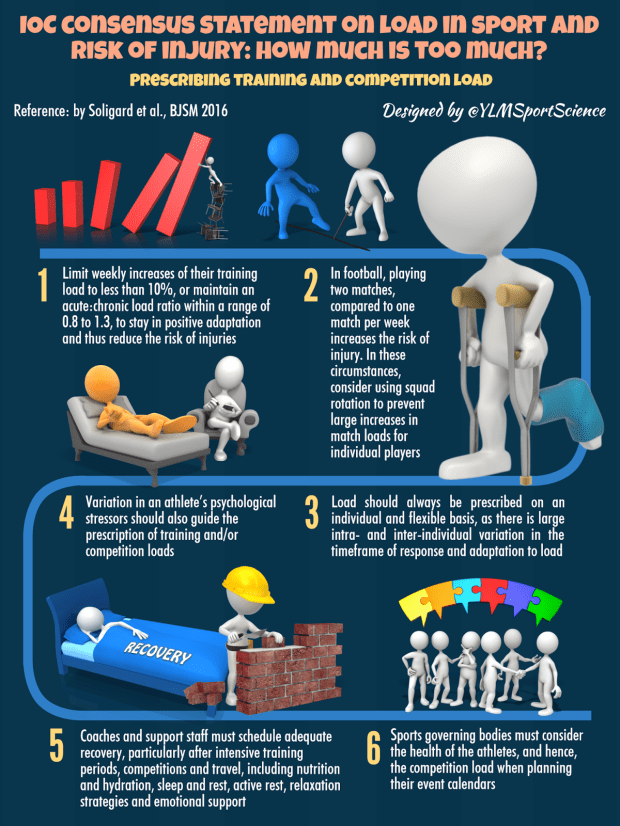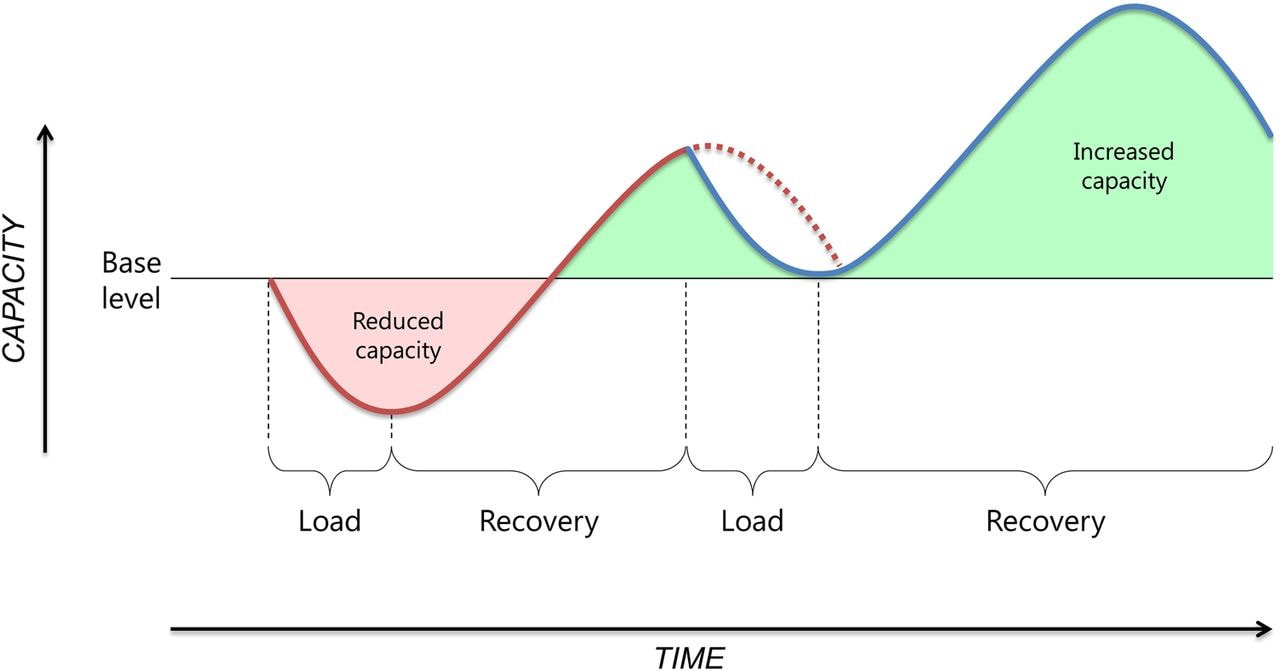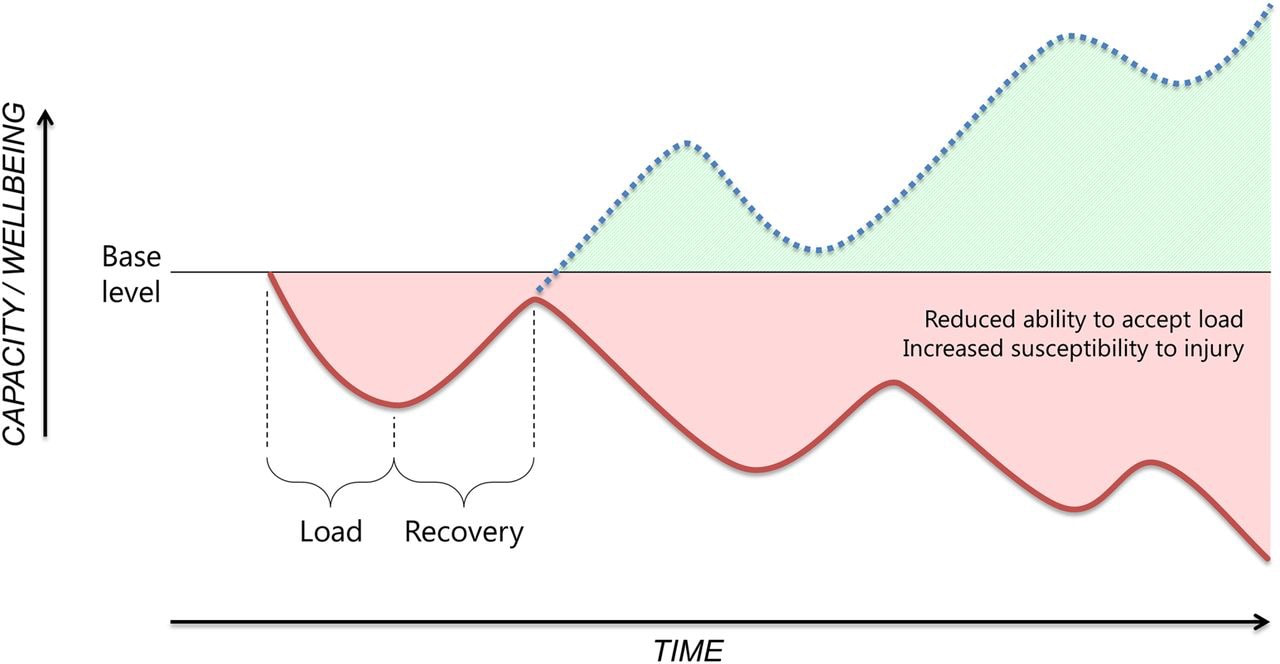Load Management and Training Volume, Part 2: Are You Prepared?
Mar 07, 2019Last week, we covered the training volume in part 1 of load management. If you missed it, go check it out. Today, we’re going to take a deeper dive into components of load management itself and what you as an athlete, coach or healthcare professional can do about it.
I geek out on this stuff so get ready.
Any injury ever:
FORCE/LOAD > CAPACITY
This means any force/load that exceeds the capacity of your tissue’s ability to withstand that force/load.
Some examples:
- Acute
- Defensive football player tackles a running back at his knees, helmet makes contact to one knee and tears his ACL and MCL – the force of the defensive player exceeded the running back’s ACL and MCL’s capacity to withstand the tackle
- It’s Monday a.k.a. International Chest Day and a gym bro is trying to get his pecs huge – his goal is to finish his workout with 100 dips. He feels a pop from his left pec on dip 69 - the force/load of the dips exceeded the left pec’s capacity to withstand more dips
- Chronic
- Crossfitter has ring muscle ups in her workout 3 times within a given week. Her last metcon of the week was for time and she had to get to the top of the leaderboard. She pushed through, but her right anterior shoulder is screaming at her. The load on her biceps tendon has been toe-ing the line with its capacity. This a great example of overloading beyond the body’s ability to recover from the stressor (in this case – ring muscle up).
- Soccer player is practicing 3-4 times per week as the season kicks off with 1-2 games each weekend. The bottom of his right foot starts to hurt after the first two weeks. He takes a practice off to see if it feels better, but it comes right back. The load on his foot has been toe-ing the line with its capacity. This a great example of overloading beyond the body’s ability to recover from the stressor (in this case – soccer practice and his plantar fascia).
Enter LOAD MANAGEMENT.
The goal is simple: to protect you from injury and maximize performance
Proper training must be prescribed. Over-training and under-training both increase risk of injury.
You want to:
- Maximize the positive effects (i.e. fitness, readiness and performance)
- Minimize the negative effects (i.e. excessive fatigue, injury and illness)
I’d be remiss to not give credit where credit is due: Tim Gabbett and company have been leading the front on this area and are really changing the way teams and athletes are handling training.
Now, let’s define LOAD:
It is broken down into 2 variables – external load and internal load
- External load - distance run, distance walked, weight lifted, repeated sprints/jumps, etc.
- Internal load - heart rate (HR), rate of perceived exertion (RPE) and/or well-being scores
We use these two variables to create the:
ACUTE: CHRONIC WORKLOAD RATIO (ACWR)
This is also commonly referred to as FATIGUE compared to FITNESS. Fatigue being the acute workload and fitness being the chronic workload.
- Acute workload is the total load over a 1 week time frame.
- Chronic workload is the average acute load over a 3-6 week time frame (very commonly 4 weeks).
With technology nowadays, we have a number of ways to track this type of data. The most commonly cited method in the research is Session RPE (sRPE), which is time (total number of minutes) multiplied by the RPE for a given training session. The RPE is usually taken after a training session to gauge level of exertion/difficulty. This is measured as “arbitrary units” or “exertional units”.
For example, in week 5, let’s say a soccer player practices one day for 60 minutes at an RPE of 8. That gives us: 60 x 8 = 480 units. She practices 4 times during week 5 with a similar intensity. This gives us our ACUTE WORKLOAD (4 x 480 = 1920 units) for week 5.
Now we have to look at her CHRONIC WORKLOAD for weeks 1-4.
- Week 1 – 1700 units
- Week 2 – 1850 units
- Week 3 – 1780 units
- Week 4 – 1900 units
- Average Week 1-4 Workload: 1808 units
When we compare the two, you get:
1920/1808 = 1.06
Now what does this number tell us?
This ratio helps delineate whether you as the athlete are prepared for the task at hand – what you’ve done compared to what you’re prepared for – that can be a running a marathon, doing a CrossFit Open workout, playing in a professional football game or doing parkour in your living room.
In terms of injury risk, acute:chronic workload ratios within the range of 0.8–1.3 is considered the training ‘sweet spot’ where injury risk is at its lowest, while acute:chronic workload ratios ≥1.5 represent the danger zone. If you look at the trend of the curve before 0.80, you should notice the injury risk climbs back up – similar to a “U-shaped” curve. This relationship between workload and injury demonstrates that both inadequate and excessive workloads are associated with injury.
Now let’s say from the example above that week 5 workload came out to 3500 arbitrary units.
That would make the ratio: 3500/1808 = 1.94
No bueno.
This athlete is at an increased risk of injury.
When training load is fairly constant (ranging from 5% less to 10% more than the previous week) players had <10% risk of injury based on the study by Gabbett et al.
However, when training load was increased by ≥15% above the previous week's load, injury risk escalated to between 21% and 49%. This is commonly represented by ‘spikes’ in acute load relative to chronic load.
To minimize the risk of injury, we should limit weekly training load increases to <10%. There’s room to work within this, but a great starting point.
Athletes accustomed to high chronic loads have fewer injuries than those accustomed to lower loads, and this supports Gabbett’s assertion that higher chronic loads can act as a protective effect against future injury.

These two graphs give a great depiction of what happens when load is applied appropriately:

Compared to excessive load and/or lack of recovery:

This is something I use every day with my patients and athletes. I’ll look at their training program and see if there is a mismatch in training volume and load management. We start here then look to optimize other components of injury and performance training such as stress management, tissue tolerance, biomechanics, physiology, strength, power, etc. At the end of the day, ask yourself this question: Is your body prepared for the demand of the task?
Cheers,
Dr. Ravi Patel, PT, DPT, CSCS
References:
- The training—injury prevention paradox: should athletes be training smarter and harder?” Br J Sports Med. 2016 Mar; 50(5): 273–280.
- Debunking the myths about training load, injury and performance: empirical evidence, hot topics and recommendations for practitioners. Br J Sports Med. 2018 Oct 26
- The athlete monitoring cycle: a practical guide to interpreting and applying training monitoring data. Br J Sports Med. 2017 Oct;51(20):1451-1452
- Pain and fatigue in sport: are they so different? Br J Sports Med. 2018 May;52(9):555-556
- Monitoring Athlete Training Loads: Consensus Statement. Int J Sports Physiol Perform. 2017 Apr;12(Suppl 2):S2161-S2170
- Why do workload spikes cause injuries, and which athletes are at higher risk? Mediators and moderators in workload-injury investigations. Br J Sports Med. 2017 Jul;51(13):993-994.
Let us help you figure out to live your best active life today!
Remember, Movement is Medicine!

